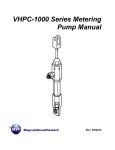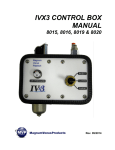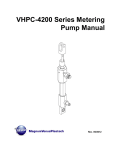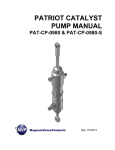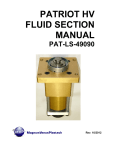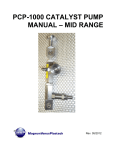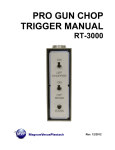Download ATG Gel Coat Gun Manual
Transcript
ATG GEL COAT GUN MANUAL Rev. 07/2014 ATG Chopper Gun Manual CORPORATE HEADQUARTERS and MANUFACTURING 200A Perimeter Park Road · Knoxville, TN 37922 · USA · Tel: +1 (865) 321-8809 TECHNOLOGY CENTER and MANUFACTURING 1862 Ives Ave. * Kent, WA 98032 * Tel 253-854-2660 * Fax 253-854-1666 E-mail: [email protected] · www.mvpind.com Rev. 07/2014 Page | 2 ATG Chopper Gun Manual Table of Contents: SECTION: Page SAFETY & WARNING INFORMATION 4 INTRODUCTION 13 GUN DISASSEMBLY 15 GUN HEAD REPAIR 17 TROUBLE SHOOTING GUIDE 21 PARTS DRAWING SECTION 23 REVISION INFORMATION 79 Rev. 07/2014 Page | 3 ATG Chopper Gun Manual SAFETY & WARNING INFORMATION: OPERATING YOUR POLYESTER SYSTEM SAFELY 1. Introduction Any tool, if used improperly, can be dangerous. Safety is ultimately the responsibility of those using the tool. In like manner, safe operation of polyester processes is the responsibility of those who use such processes and those who operate the equipment. This manual outlines procedures to be followed in conducting polyester operations safety. This system has been specifically designed for use of Polyester Resin, Gel-Coat, and Methyl Ethyl Ketone Peroxides (MEKP) applications. Other formulations or blends considered for use in this equipment is strictly prohibited without the expressed consent by Magnum Venus Products Inc. Magnum Venus Products cannot eliminate every danger nor foresee every circumstance that might cause an injury during equipment operation. Some risks, such as the high pressure liquid stream that exits the spray tip, are inherent to the nature of the machine operation and are necessary to the process in order to manufacture the end-product. For this reason, ALL personnel involved in polyester operations should read and understand the Safety Manual. It is very important for the safety of employees involved in the operation that equipment operators, maintenance and supervisory personnel understand the requirements for safe operation. Each user should examine his own operation, develop his own safety program and be assured that his equipment operators follow correct procedures. Magnum Venus Products hopes that this manual is helpful to the user and recommends that the precautions in this manual be included in any such program. Magnum Venus Products recommends this Safety Manual remain on your equipment at all times for your personnel safety. In addition to the manual, Magnum Venus Products recommends that the user consult the regulations established under the Occupational Safety & Health Act (OSHA), particularly the following sections: 1910.94 Pertaining to Ventilation. 1910.106 Pertaining to flammable liquids 1910.107 Pertaining to spray finishing operations, particularly Paragraph (m) Organic Peroxides and Dual Component Coatings. Other standards and recognized authorities to consult are the National Fire Protection Association (NFPA) bulletins as follows: NFPA No.33 Chapter 14, Organic Peroxides and Dual Component Materials NFPA No.63 Dust Explosion Prevention NFPA No.70 National Electrical Code NFPA No.77 Static Electricity NFPA No.91 Blower and Exhaust System NFPA No.654 Plastics Industry Dust Hazards Rev. 07/2014 Page | 4 ATG Chopper Gun Manual Type of Fire Extinguishing equipment recommended: Fire Extinguisher – code ABC, rating number 4a60bc. Extinguishing Media – Foam, Carbon Dioxide, Dry Chemical, Water Fog. Copies of the above bulletins are available, at a nominal charge from: National Fire Protection Association 470 Atlantic Avenue Boston, MA 02210 Research Report No.11 of the American Insurance Association deal with “Fire, Explosion and Health Hazards of Organic Peroxides”. It is published by: American Insurance Association 85 John Street New York, NY 10038 Local codes and authorities also have standards to be followed in the operation of your spraying equipment. Your insurance carrier will be helpful in answering questions that arise in your development of safe procedures. 1.2 Personal Safety Equipment Magnum Venus Products recommends the following Personal Safety Equipment for conducting safe operations of the Polyester Systems: Magnum Venus Products recommends that the user consult the state and local regulations established for all Safety equipment listed. 2.0 Material Safety 2.1 Hazards Associated with Laminating Operations The major hazards which should be guarded against in polyester laminating operations are those associated with: 1. The flammability and explosion dangers of the catalyst normally used – Methyl Ethyl Ketone Peroxide (MEKP). 2. The flammability dangers of clean-up solvents sometimes used (Magnum Venus Products recommends that clean-up solvents be non-flammable), and of resin diluents used, such as styrene. 3. The flammability dangers of catalyst diluents, if used. (Magnum Venus Products recommends that catalyst not be diluted. 4. The flammability dangers of the uncured liquid resins used. 5. The combustibility dangers of the cured laminate, accumulations of over spray, and laminate sandings. 6. The toxicity dangers of all the chemicals used in laminating operations with respect to ingestion, inhalation and skin and eye hazards. Rev. 07/2014 Page | 5 ATG Chopper Gun Manual 2.2 Catalyst (Methyl Ethyl Ketone Peroxide) MEKP is among the more hazardous materials found in commercial channels. The safe handling of the “unstable (reactive)” chemicals presents a definite challenge to the plastics industry. The highly reactive property which makes MEKP valuable to the plastics industry in producing the curing reaction of polyester resins also produces the hazards which require great care and caution in its storage, transportation, handling, processing and disposal. MEKP is a single chemical. Various polymeric forms may exist which are more or less hazardous with respect to each other. These differences may arise not only from different molecular structures (all are, nevertheless, called “MEKP”) and from possible trace impurities left from the manufacture of the chemicals, but may also arise by contamination of MEKP with other materials in its storage or use. Even a small amount of contamination with acetone, for instance, may produce an extremely shock-sensitive and explosive compound. Contamination with promoters or materials containing promoters, such as laminate sandings, or with any readily oxidizing material, such as brass or iron, will cause exothermic “redox” reactions which can become explosive in nature. Heat applied to MEKP, or heat build-up from contamination reactions can cause it to reach what is called its Self-Accelerating Decomposition Temperature (SADT). Researchers have reported measuring pressure rates-of-rise well in excess of 100,000 psi per second when certain MEKP’s reach their SADT. (For comparison, the highest pressure rate-ofrise listed in NFPA Bulletin NO.68, “Explosion Venting”, is 12,000 psi per second for an explosion of 12% acetylene and air. The maximum value listed for a hydrogen explosion is 10,000 psi per second. Some forms of MEKP, if allowed to reach their SADT, will burst even an open topped container. This suggests that it is not possible to design a relief valve to vent this order of magnitude of pressure rate-of-rise. The user should be aware that any closed container, be it a pressure vessel, surge chamber, or pressure accumulator, could explode under certain conditions. There is no engineering substitute for care by the user in handling organic peroxide catalysts. If, at any time, the pressure relieve valve on top of the catalyst tank should vent, the area should be evacuated at once and the fire department called. The venting could be the first indication of a heat, and therefore, pressure build-up that could eventually lead to an explosion. Moreover, if a catalyst tank is sufficiently full when the pressure relief valve vents, some catalyst may spray out, which could cause eye injury. For this reason, and many others, anyone whose job puts them in an area where this vented spray might go, should always wear full eye protection even when laminating operations are not taking place. Safety in handling MEKP depends to a great extent on employee education, proper safety instructions and safe use of the chemicals and equipment. Workers should be thoroughly informed of the hazards that may result from improper handling of MEKP, especially in regards to contamination, heat, friction and impact. They should be thoroughly instructed regarding the proper action to be taken in the storage, use and disposal of MEKP and other hazardous materials used in the laminating operation. In addition, users should make every effort to: A. Store MEKP in a cool, dry place in original containers away from direct sunlight and away from other chemicals. B. Keep MEKP away from heat, sparks and open flames. Rev. 07/2014 Page | 6 ATG Chopper Gun Manual C. Prevent contamination of MEKP with other materials, including polyester over spray and sandings, polymerization accelerators and promoters, brass, aluminum and non-stainless steels. D. Never add MEKP to anything that is hot, since explosive decomposition may result. E. Avoid contact with skin, eyes and clothing. Protective equipment should be worn at all times. During clean-up of spilled MEKP, personal safety equipment, gloves and eye protection must be worn. Firefighting equipment should be at hand and ready. F. Avoid spillage, which can heat up to the point of self-ignition. G. Repair any leaks discovered in the catalyst system immediately, and clean up the leaked catalyst at once in accordance with the catalyst manufacturer’s instructions. H. Use only original equipment or equivalent parts from Magnum Venus Products in the catalyst system (i.e.: hoses, fitting, etc.) because a dangerous chemical reaction may result between substituted parts and MEKP. I. Catalyst accumulated from the purging of hoses or the measurement of fluid output deliveries should never be returned to the supply tank, such catalyst should be diluted with copious quantities of clean water and disposed of in accordance with the catalyst manufacturer’s instructions. The extent to which the user is successful in accomplishing these ends and any additional recommendations by the catalyst manufacturer determines largely the safety that will be present in his operation. 2.3 Clean-Up Solvents and Resin Diluents WARNING A hazardous situation may be present in your pressurized fluid system! Hydrocarbon Solvents can cause an explosion when used with aluminum or galvanized components in a closed (pressurized) fluid system (pump, heaters, filters, valves, spray guns, tanks, etc.). The explosion could cause serious injury, death and/or substantial property damage. Cleaning agents, coatings, paints, etc. may contain Halogenated Hydrocarbon Solvents. Some Magnum Venus Products spray equipment includes aluminum or galvanized components and will be affected by Halogenated Hydrocarbon Solvents. A. There are three key elements to the Halogenated Hydrocarbon (HHC) solvent hazard. a. The presence of HHC solvents. 1,1,1 – Trichloroethane and Methylene Chloride are the most common of these solvents. However, other HHC solvents are suspect if used; either as part of paint or adhesives formulation, or for clean-up flushing. b. Aluminum or Galvanized Parts. Most handling equipment contains these elements. In contact with these metals, HHC solvents could generate a corrosive reaction of a catalytic nature. b. Equipment capable of withstanding pressure. When HHC solvent contacts aluminum or galvanized parts inside a closed container such as a pump, spray gun, or fluid handling system, the chemical reaction can, over time, result in a build-up of heat and pressure, which can reach explosive proportions. Rev. 07/2014 Page | 7 ATG Chopper Gun Manual When all three elements are present, the result can be an extremely violent explosion. The reaction can be sustained with very little aluminum or galvanized metal; any amount of aluminum is too much. A. The reaction is unpredictable. Prior use of an HHC solvent without incident (corrosion or explosion) does NOT mean that such use is safe. These solvents can be dangerous alone (as a clean-up or flushing agent) or when used as a component or a coating material. There is no known inhibitor that is effective under all circumstances. Furthermore, the mixing of HHC solvents with other materials or solvents, such as MEKP, alcohol, and toluene, may render the inhibitors ineffective. B. The use of reclaimed solvents is particularly hazardous. Reclaimers may not add any inhibitors. Also, the possible presence of water in reclaimed solvents could feed the reaction. C. Anodized or other oxide coatings cannot be relied upon to prevent the explosive reaction. Such coatings can be worn, cracked, scratched, or too thin to prevent contact. There is no known way to make oxide coatings or to employ aluminum alloys, which will safely prevent the chemical reaction under all circumstances. D. Several solvent suppliers have recently begun promoting HHC solvents for use in coating systems. The increasing use of HHC solvents is increasing the risk. Because of their exemption from many State Implementation Plans as Volatile Organic Compounds (VOC’s), their low flammability hazard, and their not being classified as toxic or carcinogenic substances, HHC solvents are very desirable in many respects. WARNING: Do not use Halogenated Hydrocarbon solvents in pressurized fluid systems having aluminum or galvanized wetted parts. NOTE: Magnum Venus Products is aware of NO stabilizers available to prevent Halogenated Hydrocarbon solvents from reaction under all conditions with aluminum components in closed fluid system. TAKE IMMEDIATE ACTION… Halogenated Hydrocarbon solvents are dangerous when used with aluminum components in a closed fluid system. A. Consult your material supplier to determine whether your solvent or coating contains Halogenated Hydrocarbon Solvents. B. Magnum Venus Products recommends that you contact your solvent supplier regarding the best non-flammable clean-up solvent with the heat toxicity for your application. C. If, however, you find it necessary to use flammable solvents, they must be kept in approved, electrically grounded containers. D. Bulk solvent should be stored in a well-ventilated, separate building, 50 feet away from your main plant. E. You should allow only enough solvent for one day’s use in your laminating area. F. “NO SMOKING” signs must be posted and observed in all areas of storage or where solvents and other flammable materials are used. Rev. 07/2014 Page | 8 ATG Chopper Gun Manual G. Adequate ventilation (as covered in OSHA Section 1910.94 and NFPA No.91) is important wherever solvents are stored or used, to minimize, confine and exhaust the solvent vapors. H. Solvents should be handled in accordance with OSHA Section 1910.106 and 1910.107. 2.4 Catalyst Diluents Magnum Venus Products spray-up and gel-coat systems currently produced are designed so that catalyst diluents are not required. Magnum Venus Products, therefore, recommends that diluents not be used. This avoids the possible contamination which could lead to an explosion due to the handling and mixing of MEKP and diluents. In addition, it eliminates any problems from the diluents being contaminated through rust particles in drums, poor quality control on the part of the diluents suppliers, or any other reason. If, however, diluents are absolutely required, contact your catalyst supplier and follow his instructions explicitly. Preferable, the supplier should premix the catalyst to prevent possible “on the job” contamination while mixing. WARNING If diluents are not used, it should be remembered that catalyst spillage, gun, hose and packing leaks are potentially more hazardous, since each drop contains a higher concentration of catalyst, and therefore will react quicker with over spray and the leak. 2.5 Cured Laminate, Overspray and Laminate Sandings Accumulation A. Remove all accumulations of overspray, FRP sandings, etc. from the building as they occur. If this waste is allowed to build up, spillage of catalyst is more likely to start a fire; in addition, the fire would burn hotter and longer. B. Floor coverings, if used, should be non-combustible. C. Spilled or leaked catalyst may cause a fire if it comes in contact with an FRP product, oversprayed chop or resin, FRP sandings or any other material with MEKP. To prevent this spillage and leakage, you should: 1. Maintain your Magnum Venus Products System. Check the gun several times daily for catalyst and resin packing or valve leaks. REPAIR ALL LEAKS IMMEDIATELY. 2. Never leave the gun hanging over, or lying inside the mold. A catalyst leak in this situation would certainly damage the part, possibly the mold, and may cause a fire. 3. Inspect resin and catalyst hoses daily for wear or stress at the entry and exits of the boom sections and at the hose and fittings. Replace if wear or weakness is evident or suspected. 4. Arrange the hoses and fiberglass roving guides so that the fiberglass strands DO NOT rub against any of the hoses at any point. If allowed to rub, the hose will be cut through, causing a hazardous leakage of material which could increase the danger of fire. Also, the material may spew onto personnel in the area. Rev. 07/2014 Page | 9 ATG Chopper Gun Manual 2.7 Toxicity of Chemicals A. Magnum Venus Products recommends that you consult OSHA Sections 1910.94, 1910.106, 1910.107 and NFPA No.33, Chapter 14, and NFPA No.91. B. Contact your chemical supplier(s) and determine the toxicity of the various chemicals used as well as the best methods to prevent injury, irritation and danger to personnel. C. Also determine the best methods of first aid treatment for each chemical used in your plant. 2.8 Treatment of Chemical Injuries Great care should be used in handling the chemicals (resins, catalyst and solvents) used in polyester systems. Such chemicals should be treated as if they hurt your skin and eyes and as if they are poison to your body. For this reason, Magnum Venus Products recommends the use of protective clothing and eye wear in using polyester systems. However, users should be prepared in the event of such an injury. Precautions include: 1. Know precisely what chemicals you are using and obtain information from your chemical supplier on what to do in the event the chemical gets onto your skin or into the eyes, or is swallowed. 2. Keep this information together and easily available so that it may be used by those administering first aid or treating the injured person. 3. Be sure the information from your chemical supplier includes instructions on how to treat any toxic effects the chemicals have. WARNING Contact your doctor immediately in the event of any injury and give him the information you have collected. If your information includes first aid instructions, administer first aid immediately while you are contacting your doctor. Fast treatment of the outer skin and eyes that contact such chemicals generally includes immediate and thorough washing of the exposed skin and immediate and continuous flushing of the eyes with lots of clean water for at least 15 minutes or more. These general instructions of first aid treatment, however, may be incorrect for some chemicals; that is why you must know the chemicals and treatment before an accident occurs. Treatment for swallowing a chemical frequently depends upon the nature of the chemical. NOTE: Refer to your System User Manual for complete and detailed operating instructions and service information. Rev. 07/2014 Page | 10 ATG Chopper Gun Manual 3.0 Equipment Safety WARNING Magnum Venus Products suggests that personal safety equipment such as EYE GOGGLES, GLOVES, EAR PROTECTION, and RESPIRATORS be worn when servicing or operating this equipment. Ear protection should be worn when operating a fiberglass chopper to protect against hearing loss since noise levels can be as high as 116 dB (decibels). This equipment should only be operated or serviced by technically trained personnel! WARNING Never place fingers, hands, or any body part near or directly in front of the spray gun fluid tip. The force of the liquid as it exits the spray tip can cause serious injury by shooting liquid through the skin. NEVER LOOK DIRECTLY INTO THE GUN SPRAY TIP OR POINT THE GUN AT OR NEAR ANOTHER PERSON. (TREAT THE GUN AS IF IT WERE A LOADED PISTOL.) 3.1 Emergency Stop Procedures The following steps should be followed in order to stop the machinery in an emergency situation 1. The ball valve located where the air enters the power head of the resin pump, should be moved to the “OFF” or closed position. To do this, simply rotate the lever on the ball valve 90 degrees. Doing this will cause all the system air to bleed out of the system in a matter of a few seconds, making the system incapable of operating NOTE: Step 2 is a precautionary step and should be followed whenever the above mentioned ball valve is activated to the stop mode. Failure to do so, can damage the regulators and components on reactivating to the “ON” position. 2. Turn all system regulators to the “OFF” position (counter-clockwise) position NOTE: Verify that the Catalyst relief line, located on the catalyst manifold, and the resin return line, located on the resin filter, are secured relieving catalyst and resin fluid pressure. 3. Catalyst pressure in the catalyst pump can be eliminated by rotating the ball valve on the catalyst manifold 90 degrees to the “open” or “on” position. Note: The “open” or “on” position is when the ball valve handle is parallel (in line) with the ball valve body. The “closed” or “off” position is when the ball valve handle is perpendicular (across) the ball valve body. 4. Resin pressure in the resin pump can be eliminated by rotating the ball valve on the resin filter 90 degrees to the “open” or “on” position. Place a container under the ball valve to catch any resin that is ejected out of the valve. Rev. 07/2014 Page | 11 ATG Chopper Gun Manual 3.2 Grounding Grounding an object means providing an adequate path for the flow of the electrical charge from the object to the ground. An adequate path is one that permits charge to flow from the object fast enough that it will not accumulate to the extent that a spark can be formed. It is not possible to define exactly what will be an adequate path under all conditions since it depends on many variables. In any event, the grounding means should have the lowest possible electrical resistance. Grounding straps should be installed on all loose conductive objects in the spraying area. This includes material containers and equipment. Magnum Venus Products recommends grounding straps be made of AWG No.18 stranded wire as a minimum and the larger wire be used where possible. NFPA Bulletin No77 states that the electrical resistance of such a leakage path may be as low as 1 meg ohm (10 ohms) but that resistance as high as 10,000 meg ohms will produce an adequate leakage path in some cases. Whenever flammable or combustible liquids are transferred from one container to another, or from one container to the equipment, both containers or container and equipment shall be effectively bonded and grounded to dissipate static electricity. For further information, see National Fire Protection Association ( NFPA) 77, titled “Recommended Practice on Static Electrical”. Refer especially to section 7-7 titled “Spray Application of Flammable and Combustible Materials”. Check with local codes and authorities for other specific standards that might apply to your application. NEVER USE HARD MATERIALS SUCH AS WIRE, PINS, ETC., TO CLEAR A PLUGGED GUN. HARD MATERIALS CAN CAUSE PERMANENT DAMAGE. DAB WITH A BRISTLE BRUSH, BLOW BACKWARDS WITH AIR UNTIL CLEAR WHILE WEARING A PROTECTIVE EYE SHIELD. REPEAT AS MANY TIMES AS NECESSARY. DO NOT PERFORM ANY MAINTENANCE OR REPAIRS UNTIL YOU HAVE FOLLOWED THE PRECAUTIONS STATED ABOVE. IF YOU, AS AN EQUIPMENT OPERATOR OR SUPERVISOR, DO NOT FEEL THAT YOU HAVE BEEN ADEQUATELY TRAINED OR INSTRUCTED AND THAT YOU LACK THE TECHNICAL KNOWLEDGE TO OPERATE OR PERFORM MAINTENANCE ON A PIECE OF MAGNUM VENUS PRODUCTS EQUIPMENT, PLEASE CALL MAGNUM VENUS PRODUCTS BEFORE OPERATING OR PERFORMING MAINTENANCE ON THE EQUIPMENT. IF YOU HAVE ANY QUESTIONS REGARDING THE ABOVE PRECAUTIONS OR ANY SERVICE OR OPERATION PRECEDURES, CALL YOUR MAGNUM VENUS PRODUCTS DISTRIBUTOR OR MAGNUM VENUS PRODUCTS. NOTICE: All statements, information and data given herein are believed to be accurate and reliable but are presented without guaranty, warranty or responsibility of any kind express or implied. The user should not assume that all safety measures are indicated or that other measures are not required. DANGER: Contaminated catalyst may cause Fire or Explosion. Before working on the catalyst pump or catalyst accumulator, wash hands and tools thoroughly. Be sure work area is free of dirt, grease or resin. Clean catalyst system components with clean water only. DANGER: Eye, skin and respiration hazard. The Catalyst, MEKP, may cause blindness, skin irritation or breathing difficulty. Keep hands away from face. Keep food and drink away from work area. WARNING: Please refer to your catalyst manufacturer’s safety information regarding the safe handling and storage of catalyst. Wear appropriate safety equipment as recommended. Rev. 07/2014 Page | 12 ATG Chopper Gun Manual Introduction: The AT series guns are one of the most advanced state of the art guns introduced into the composites industry. The AT gun series features low maintenance, few adjustments, superb quality and a long service life. These guns will assist you in the production of a superior product. The AT series guns are “air trigger” guns. As the gun trigger is pulled air is shifted from one side of a piston to the other, the pistons are attached to the gun needles and thus opens and closes the needles. This manual, the ATG GEL COAT GUN MANUAL, provides information you need to perform simple maintenance and repair on your equipment. Step-by-step assembly and disassembly procedures are included for each component. A troubleshooting guide helps you diagnose and perform common repair situations. Please read the manual carefully. Follow the steps in the order given, otherwise you may damage the equipment or injure yourself. DANGER: To prevent accidental injection injury, disconnect all air and electrical power to the unit before beginning repair or maintenance on this equipment. During Disassembly: As you disassemble the equipment, lay out the components on a clean surface in the correct order and direction. This will help you to reassemble them. This manual covers all the variations of the ATG Gel Coat Gun: ATG-3500-XXX ATG-6500-XXX EXTERNAL MIX GEL COAT GUN EXTERNAL MIX GEL COAT GUN – WITH SIGNAL Rev. 07/2014 Page | 13 ATG Chopper Gun Manual This page was left blank intentionally Rev. 07/2014 Page | 14 ATG Chopper Gun Manual Gun Disassembly: 1. Remove the two (2) Allen screws from the side of the gun. This will separate the gun into two (2) components, handle and head / cylinder. 2. Remove the two (2) screws on the back of the cylinder and using caution remove the cylinder from the back of the gun head. The gun is now in three (3) components, handle, head and cylinder. We will rebuild each component and then reassemble them. Handle Disassembly 3. Loosen the set screw holding the trigger button assembly on and remove the button. 4. Unscrew and remove the trigger lock. 5. Remove the trigger housing 6. Remove the trigger valve assembly from the front of the gun. 7. Unscrew the refinement air adjustment screw and from the side of the gun. 8. Remove the refinement air spring from the side of the gun and adjustment screw. 9. Unscrew the refinement air packing nut from the side of the gun and remove the Orings. 10. Remove the three (3) O-rings on the top of the handle. Rev. 07/2014 Page | 15 ATG Chopper Gun Manual Handle Assembly Note: Thoroughly clean and inspect all parts for wear or damage. Replace all parts with original MVP parts. Open the seal kit and match the O-rings with the ones being replaced. 11. Replace the O-rings on the trigger valve. Note: A special tool is available to install the O-rings on the trigger valve – Trigger Valve O-ring Tool ATC-40103-1. 12. Install the spring on to the trigger valve and install into the front of the gun. 13. Thread the trigger housing into the front of the gun over the trigger valve using a 7/16 wrench. 14. Thread the trigger lock into the trigger housing. 15. Place the trigger button on to the end of the trigger valve depressing it all the way, and then tighten the set screw on the side of the trigger button to hold it in place. 16. Replace the O-rings in the air refinement needle valve on the side of the handle, the Buna (black) O-ring first then the Teflon (white). 17. Install the packing nut, just till it stops. 18. Place the spring onto the refinement air needle. 19. Lubricate with Super O Lube and install the refinement air needle into the side of the gun. 20. Replace the O-rings on top of the handle. These O-rings seal the cylinder and gun head to the handle. Set the handle aside for now. Cylinder Repair 1. Remove and check the spring. 2. Check the inside of the cylinder 3. Check and clear air ports on the bottom of the cylinder. 4. Lubricate (SSL-10) the inside of the cylinder. 5. Reinstall spring into the cylinder. Rev. 07/2014 Page | 16 ATG Chopper Gun Manual Gun Head Repair: 1. Remove the Catalyst spool valve assembly; note it consists of two (3) pieces. 2. Unscrew the Valve Back from the Catalyst Piston, using caution not to lose the lock nut. 3. Replace the O-rings on the Valve Back and Catalyst Piston. Note: A special tool is available to install the O-rings on the catalyst spool valve – Catalyst Valve O-ring Tool ATC-40204-1. 4. Install the Lock Washer on the Valve Back. 5. Thread the Valve Back into the Catalyst Piston. Note: Use a drop of removable thread lock compound on threads of the Valve Front and Valve Back during reassembly. 6. Unscrew the Valve Front for the Valve Back – Note this is a reverse thread. Note: The threads on the Valve Front are reverse threads and will unscrew clockwise from the Valve Back. 7. Install new O-Rings on the Valve Front and O-Ring between the Valve Front and Valve Back 8. Thread the Valve Front into the Valve Back – Note this is a reverse thread. Set Catalyst Spool aside for now. 9. Install a new O-ring onto the catalyst cylinder on the gun head. 10. Remove the two set screws on the side of the gun head assembly holding the catalyst cylinder in place. 11. Remove catalyst cylinder from the gun head. Note: Make note of the O-ring positions on the catalyst cylinder. Installing the new O-rings in the wrong positions will cause the gun to not work properly. 12. Replace the old O-ring with the new O-rings from the seal kit. 13. Lubricate the O-rings with SSL-10 or Vaseline. Rev. 07/2014 Page | 17 ATG Chopper Gun Manual Note: The hole in the catalyst cylinder has to line up with the hole in the gun head that the set screw will be installed into. 14. Reinstall the catalyst cylinder into the gun head by rotating it back and forth while pushing it into the gun head. Use caution not to damage the O-rings. Align the hole in the catalyst cylinder with the hole in the side of the gun head. Set Screw Set Screw with Catalyst Weep Hole 15. Replace the set screws back into the gun head. 16. Using a 5/16 nut driver remove the diffuser seat from the front of the gun. 17. Using special tool ATC-40323-BT remove the cartridge assembly from the front of the gun. 18. Pull the resin needle piston assembly from the back of the gun head. 19. Replace the O-ring on the resin needle piston 20. Remove the packing retainer from the back of the gun head and replace the Oring with a new one. 21. Replace the packing retainer into the back of the gun head. 22. Replace the O-ring for the resin cylinder seal. 23. Replace the two tip pin O-rings on the front of the gun. 24. Remove the catalyst cylinder plug on the front of the gun head and replace the O-ring. 25. Reinstall the catalyst cylinder plug into the front of the gun head. Rev. 07/2014 Page | 18 ATG Chopper Gun Manual 26. Replace the O-ring on the diffuser seat. 27. Using a pin and wrench loosen the needle packing housing from the packing retainer. 28. Check that the packing press moves freely in the packing housing, clean as necessary. 29. Replace the two packing in the packing housing. 30. Hand tighten the packing housing, packing press and two new packing together with the packing retainer. Note: Use caution not to over tighten the packing retainer into the packing housing as the resin needle will not go through the packing. 31. Tighten the lock nut to secure the packing housing. 32. Install the packing housing assembly (cartridge assembly) into the front of the gun head. 33. Press the diffuser seat as far as it will go into the front of the gun head. Using a 5/16 nut driver screw the diffuser seat in a few threads. 34. Install the resin needle assembly into the back of the gun head. 35. Using the 5/16 nut driver adjust the packing seat to where it is snug then just a little more. 36. Insert the catalyst spool valve assembly into the back of the gun head. 37. Using the two (2) screws attach the cylinder assembly to the gun head. 38. Attach the gun head and cylinder to the handle. Rev. 07/2014 Page | 19 ATG Chopper Gun Manual This page was left blank intentionally Rev. 07/2014 Page | 20 ATG Chopper Gun Manual Trouble Shooting Guide: BASIC TROUBLE SHOOTING GUIDE FOR MVP Air Assisted ‘AT’ Guns Problem Air leaking from exhaust port on back of handle while trigger is in OFF position. Possible Causes O-ring material worn or cut. O-rings on catalyst piston worn or cut. Recommended Solution Replace O-rings. O-rings on trigger valve worn or cut. Air leaking from exhaust port on O-rings on trigger valve worn or cut. back of handle while trigger is in O-rings on Catalyst Valve and/or OFF or ON position. Material Piston worn or nicked. Catalyst leaking from catalyst O-rings on catalyst valve worn or cut. tip while gun is sitting, not being triggered. Catalyst leaks from weep hole O-rings on catalyst valve worn or cut. on catalyst side of gun. Catalyst air piston is not actuating. No catalyst is coming from gun. Plugged catalyst restrictor (Allen screw with orifice located in front of catalyst valve). Plugged catalyst passageway in head of gun or catalyst tips. No catalyst flow to gun. Material is leaking from tip (front Loose diffuser seat. of gun) Material leaking from weep hole on material side of gun. Worn needle and/or seat. O-ring on diffuser nicked or cut. Loose diffuser seat. Worn needle packing. Rev. 07/2014 Replace O-rings. Replace O-rings. Replace O-rings. Check for clogged catalyst air passages (small holes underneath back cylinder) Note: There is more than one passageway from holes. Clean and clear orifice in front of catalyst valve. Inspect, clean and clear passageways. See “Slave Pump – Trouble Shooting.” Tighten diffuser seat ¼ to ½ turn at a time until snug and then one more ¼ turn. Over tightening of diffuser seat may cause binding of material needle. Replace worn items. Replace O-ring. Adjust until snug. Then turn ¼ to ½ turn more. Don’t over tighten. Replace packing and adjust as indicated above. Page | 21 ATG Chopper Gun Manual This page was left blank intentionally Rev. 07/2014 Page | 22 ATG Chopper Gun Manual Parts Drawings: ATG-3500 ATG-3500-A ATG-3500-FIT ATG-3500-FIT-A ATG-3500-FIT-A-INT ATG-3500-FIT-INT ATG-3500-INT ATG-3500-W ATG-6500 ATG-6500-COOK ATG-6500-FIT ATG-6500-FIT-INT ATG-6500-FIT-W ATG-6500-FIT-W-INT ATG-6500-INT ATG-6500-W ATG-6500-W-INT ATG-35402-TT External Mix Gel Coat Gun External Mix Gel Gun – Automatic External Mix Gel Coat Gun – FIT Gel Coat Gun – FIT – Automatic Gel Gun – FIT – AUTO – International Gel Gun – FIT – International Gel Coat Gun – International External Mix Gel Gun – Wetout Gel Coat Gun – with Signal Gel Coat Gun – with Signal External Mix Gel Coat Gun – FIT Gel Coat Gun – FIT - International Gel coat Gun – FIT - Wetout Gel Gun – FIT – Wetout - International Gel Gun - International Gel Coat Gun – Wetout Gel Coat Gun – Wetout - International Test Catalyst Tip Rev. 07/2014 Page | 23 ATG Chopper Gun Manual Rev. 07/2014 Page | 24 ATG Chopper Gun Manual Rev. 07/2014 Page | 25 ATG Chopper Gun Manual Rev. 07/2014 Page | 26 ATG Chopper Gun Manual Rev. 07/2014 Page | 27 ATG Chopper Gun Manual Rev. 07/2014 Page | 28 ATG Chopper Gun Manual Rev. 07/2014 Page | 29 ATG Chopper Gun Manual Rev. 07/2014 Page | 30 ATG Chopper Gun Manual Rev. 07/2014 Page | 31 ATG Chopper Gun Manual Rev. 07/2014 Page | 32 ATG Chopper Gun Manual Rev. 07/2014 Page | 33 ATG Chopper Gun Manual Rev. 07/2014 Page | 34 ATG Chopper Gun Manual Rev. 07/2014 Page | 35 ATG Chopper Gun Manual Rev. 07/2014 Page | 36 ATG Chopper Gun Manual Rev. 07/2014 Page | 37 ATG Chopper Gun Manual Rev. 07/2014 Page | 38 ATG Chopper Gun Manual Rev. 07/2014 Page | 39 ATG Chopper Gun Manual Rev. 07/2014 Page | 40 ATG Chopper Gun Manual Rev. 07/2014 Page | 41 ATG Chopper Gun Manual Rev. 07/2014 Page | 42 ATG Chopper Gun Manual Rev. 07/2014 Page | 43 ATG Chopper Gun Manual Rev. 07/2014 Page | 44 ATG Chopper Gun Manual Rev. 07/2014 Page | 45 ATG Chopper Gun Manual Rev. 07/2014 Page | 46 ATG Chopper Gun Manual Rev. 07/2014 Page | 47 ATG Chopper Gun Manual Rev. 07/2014 Page | 48 ATG Chopper Gun Manual Rev. 07/2014 Page | 49 ATG Chopper Gun Manual Rev. 07/2014 Page | 50 ATG Chopper Gun Manual Rev. 07/2014 Page | 51 ATG Chopper Gun Manual Rev. 07/2014 Page | 52 ATG Chopper Gun Manual Rev. 07/2014 Page | 53 ATG Chopper Gun Manual Rev. 07/2014 Page | 54 ATG Chopper Gun Manual Rev. 07/2014 Page | 55 ATG Chopper Gun Manual Rev. 07/2014 Page | 56 ATG Chopper Gun Manual Rev. 07/2014 Page | 57 ATG Chopper Gun Manual Rev. 07/2014 Page | 58 ATG Chopper Gun Manual Rev. 07/2014 Page | 59 ATG Chopper Gun Manual Rev. 07/2014 Page | 60 ATG Chopper Gun Manual Rev. 07/2014 Page | 61 ATG Chopper Gun Manual Rev. 07/2014 Page | 62 ATG Chopper Gun Manual Rev. 07/2014 Page | 63 ATG Chopper Gun Manual Rev. 07/2014 Page | 64 ATG Chopper Gun Manual Rev. 07/2014 Page | 65 ATG Chopper Gun Manual Rev. 07/2014 Page | 66 ATG Chopper Gun Manual Rev. 07/2014 Page | 67 ATG Chopper Gun Manual Rev. 07/2014 Page | 68 ATG Chopper Gun Manual Rev. 07/2014 Page | 69 ATG Chopper Gun Manual Rev. 07/2014 Page | 70 ATG Chopper Gun Manual Rev. 07/2014 Page | 71 ATG Chopper Gun Manual Rev. 07/2014 Page | 72 ATG Chopper Gun Manual Rev. 07/2014 Page | 73 ATG Chopper Gun Manual Rev. 07/2014 Page | 74 ATG Chopper Gun Manual Rev. 07/2014 Page | 75 ATG Chopper Gun Manual Rev. 07/2014 Page | 76 ATG Chopper Gun Manual Rev. 07/2014 Page | 77 ATG Chopper Gun Manual Rev. 07/2014 Page | 78 ATG Chopper Gun Manual Revision Information: Rev. 02/2011 Updated the drawings and manual format. The revision information chapter was added. The catalyst spool assembly procedures were revised. Rev: 01/2012 Updated the Address, Logo and drawings. Also updated the manual format Rev: 05/2012 Added the assembly list to the back cover and corrected other minor items. Rev. 11/2012 Updated the drawings Rev. 07/2014 Updated the Logo and Name. Updated the drawings. Removed reference to Plastech. Rev. 07/2014 Page | 79 ATG Chopper Gun Manual CORPORATE HEADQUARTERS and MANUFACTURING 200A Perimeter Park Road · Knoxville, TN 37922 · USA · Tel: +1 (865) 321-8809 TECHNOLOGY CENTER and MANUFACTURING 1862 Ives Ave. * Kent, WA 98032 * Tel 253-854-2660 * Fax 253-854-1666 E-mail: [email protected] · www.mvpind.com Assemblies Covered in this Manual: ATG-3500-XXX ATG-6500-XXX EXTERNAL MIX GEL COAT GUN EXTERNAL MIX GEL COAT GUN – WITH SIGNAL Rev. 07/2014 Page | 80



















































































